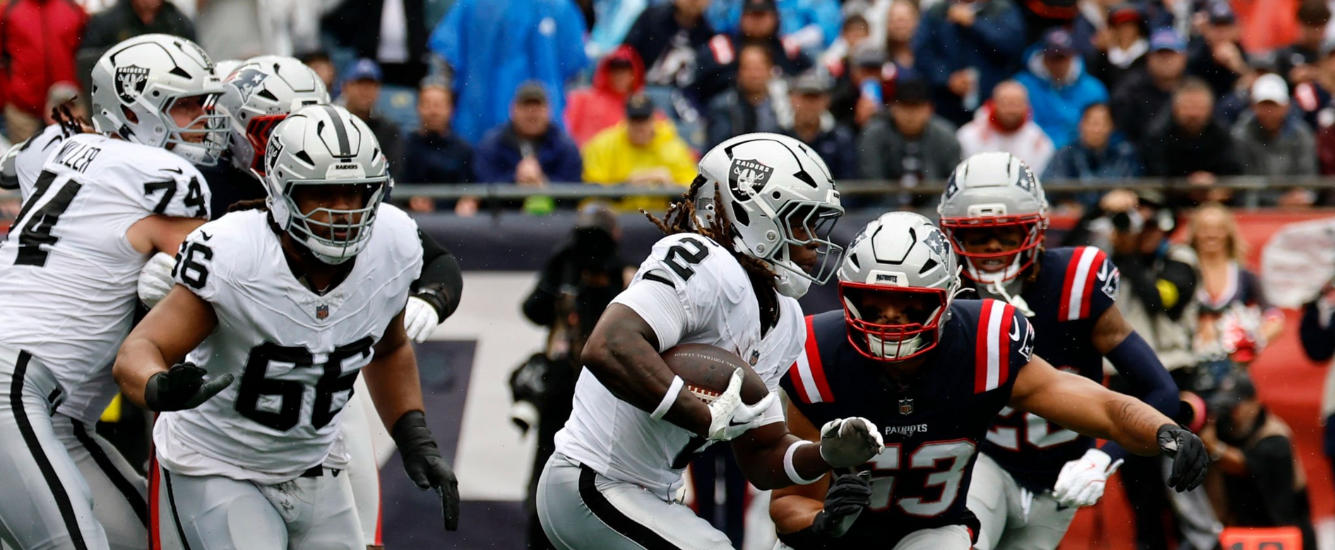The RotoViz DRAFT Roster Construction Tool allows us to analyze the win rates of specific roster constructions. In the earlier installments of the DRAFT NFL Best Ball Roster Construction Guide, we explored the win rates of teams that drafted six QBs and TEs as well as teams that limited themselves to four onesie positions. Here we will explore the win rates for teams that drafted a...
- 2025 Rookie Guide
- Monday Review
- Tools
FANTASY FOOTBALL Tools
In-Season
NOTE: Our tools will be updated each week as soon as data from our stats provider is available. Generally, data from Sunday’s games will be available early Tuesday afternoon. For an immediate look at the games from the previous weekend, please check out our Monday Review tool which includes a collection of preliminary stats.
- All NFL
All Fantasy Football Articles
 In-Season
In-SeasonWeek 16 Monday Review: It Wasn’t Just the Usual Suspects Who Showed Up Big in the Fantasy Semifinals
Kevin Szafraniec December 22, 2025 - Best Ball
- Dynasty
- Weekly GLSP
- Rankings
The Happy Medium: Roster Five QBs and TEs in DRAFT Best Ball
Please subscribe For Full Access to all RotoViz content and tools!
What’s included in your subscription??
- Exclusive Access to RotoViz Study Hall
- A treasure trove of our most insightful articles that will teach you the metrics that matter, time-tested winning strategies, the approaches that will give you an edge, and teach you how to be an effective fantasy manager.
- Revolutionary Tools
- Including the NFL Stat Explorer, Weekly GLSP Projections, NCAA Prospect Box Score Scout, Combine Explorer, Range of Outcomes App, DFS Lineup Optimizer, Best Ball Suite,and many, many, more.
- Groundbreaking Articles
- RotoViz is home of the original Zero-RB article and continues to push fantasy gamers forward as the go-to destination for evidence-based analysis and strategic advantages.
- Weekly Projections
- Built using RotoViz’s unique GLSP approach.
- Expert Rankings
- And a whole lot more…
Michael Dubner
RotoViz Featured Writer. Emphasis on NFL DFS and Best Ball.

RotoViz Staff Bold Predictions for the 2024 NFL Fantasy Football Season
Michael Dubner
August 30, 2024
We are less than one week away from the kickoff of the 2024 NFL season. We’ve had a full offseason of nonstop best ball, high stakes, and home league drafts. We’ve drafted hundreds — and in some cases thousands — of teams. The RotoViz Staff has prepared their boldest predictions that will define the 2024 fantasy football season. Michael Dubner At Least One Seahawk in…...

5 Cheap Rookie Wide Receivers Who Are Going To Explode in the Fantasy Playoffs
Michael Dubner
August 27, 2024
Scoring the most fantasy points in the fantasy playoffs seems obvious and straightforward, yet it can be tempting to get Week 1 brain with the NFL season rapidly approaching. While the 14-week fantasy football regular season accounts for 82% of the games played, all weeks are not created equal, as Weeks 16 and 17 matter more than the first 14 weeks combined. Drafting rosters with…...

If You Can Sneak This Cohort Of RBs Into The Playoffs, Their Back-Weighted Production Is Going To Win Fantasy Championships
Michael Dubner
August 20, 2024
In order to win life-changing money in best ball tournaments, we need to strategically score the most points in the weeks that matter most. In the first part of this series on back-weighted production, we reminded ourselves why not all weeks are created equal. We then explored how rookie wide receivers are the key to unlocking back-weighted production, and identified the key range of the…...
RotoViz Staff Bold Predictions for the 2024 NFL Fantasy Football Season
Michael Dubner
August 30, 2024
We are less than one week away from the kickoff of the 2024 NFL season. We’ve had a full offseason of nonstop best ball, high stakes, and home league drafts. We’ve drafted hundreds — and in some cases thousands — of teams. The RotoViz Staff has prepared their boldest predictions that will define the 2024 fantasy football season. Michael Dubner At Least One Seahawk in…...
5 Cheap Rookie Wide Receivers Who Are Going To Explode in the Fantasy Playoffs
Michael Dubner
August 27, 2024
Scoring the most fantasy points in the fantasy playoffs seems obvious and straightforward, yet it can be tempting to get Week 1 brain with the NFL season rapidly approaching. While the 14-week fantasy football regular season accounts for 82% of the games played, all weeks are not created equal, as Weeks 16 and 17 matter more than the first 14 weeks combined. Drafting rosters with…...
If You Can Sneak This Cohort Of RBs Into The Playoffs, Their Back-Weighted Production Is Going To Win Fantasy Championships
Michael Dubner
August 20, 2024
In order to win life-changing money in best ball tournaments, we need to strategically score the most points in the weeks that matter most. In the first part of this series on back-weighted production, we reminded ourselves why not all weeks are created equal. We then explored how rookie wide receivers are the key to unlocking back-weighted production, and identified the key range of the…...
Analysis

The Banana Stand: Start Your Week 17 Championship Run By Dominating on Christmas
Shawn Siegele
December 24, 2025

The Lions Take on a Minnesota Team That’s Hit Rock Bottom: D/ST Streaming, Week 17
Ross Durham
December 24, 2025

Week 17 Waivers: Let’s Go Win Some Fantasy Championships!
Kevin Szafraniec
December 23, 2025

It All Comes Down to This: Week 17 Tight End Streamers
Neil Dutton
December 23, 2025

Week 16 Monday Review: It Wasn’t Just the Usual Suspects Who Showed Up Big in the Fantasy Semifinals
Kevin Szafraniec
December 22, 2025

The RotoViz Week in Review: Rehashing the Highs and Lows of the 2025 Draft Season
Kevin Szafraniec
December 21, 2025

Game-Level Similarity Projections and Weekly Rankings: The Wrong Read, Week 16
Blair Andrews
December 20, 2025

Maybe Quinshon Judkins Isn’t the Real Problem in Cleveland: Offensive Lines and Their Fantasy Impacts, Week 16
Thomas Emerick
December 20, 2025
Related Articles
In-Season Articles
In-Season Articles

The Banana Stand: Start Your Week 17 Championship Run By Dominating on Christmas
Shawn Siegele
December 24, 2025

The Lions Take on a Minnesota Team That’s Hit Rock Bottom: D/ST Streaming, Week 17
Ross Durham
December 24, 2025

Week 17 Waivers: Let’s Go Win Some Fantasy Championships!
Kevin Szafraniec
December 23, 2025

It All Comes Down to This: Week 17 Tight End Streamers
Neil Dutton
December 23, 2025

Week 16 Monday Review: It Wasn’t Just the Usual Suspects Who Showed Up Big in the Fantasy Semifinals
Kevin Szafraniec
December 22, 2025

The RotoViz Week in Review: Rehashing the Highs and Lows of the 2025 Draft Season
Kevin Szafraniec
December 21, 2025

Game-Level Similarity Projections and Weekly Rankings: The Wrong Read, Week 16
Blair Andrews
December 20, 2025

Maybe Quinshon Judkins Isn’t the Real Problem in Cleveland: Offensive Lines and Their Fantasy Impacts, Week 16
Thomas Emerick
December 20, 2025
Related Articles

The Banana Stand: Start Your Week 17 Championship Run By Dominating on Christmas
Shawn Siegele
December 24, 2025

The Lions Take on a Minnesota Team That’s Hit Rock Bottom: D/ST Streaming, Week 17
Ross Durham
December 24, 2025

Week 17 Waivers: Let’s Go Win Some Fantasy Championships!
Kevin Szafraniec
December 23, 2025

It All Comes Down to This: Week 17 Tight End Streamers
Neil Dutton
December 23, 2025

Week 16 Monday Review: It Wasn’t Just the Usual Suspects Who Showed Up Big in the Fantasy Semifinals
Kevin Szafraniec
December 22, 2025

The RotoViz Week in Review: Rehashing the Highs and Lows of the 2025 Draft Season
Kevin Szafraniec
December 21, 2025

Game-Level Similarity Projections and Weekly Rankings: The Wrong Read, Week 16
Blair Andrews
December 20, 2025

Maybe Quinshon Judkins Isn’t the Real Problem in Cleveland: Offensive Lines and Their Fantasy Impacts, Week 16
Thomas Emerick
December 20, 2025
The Blitz

About

Sign-up today for our free Premium Email subscription!
Data provided by
© 2021 RotoViz. All rights Reserved.






